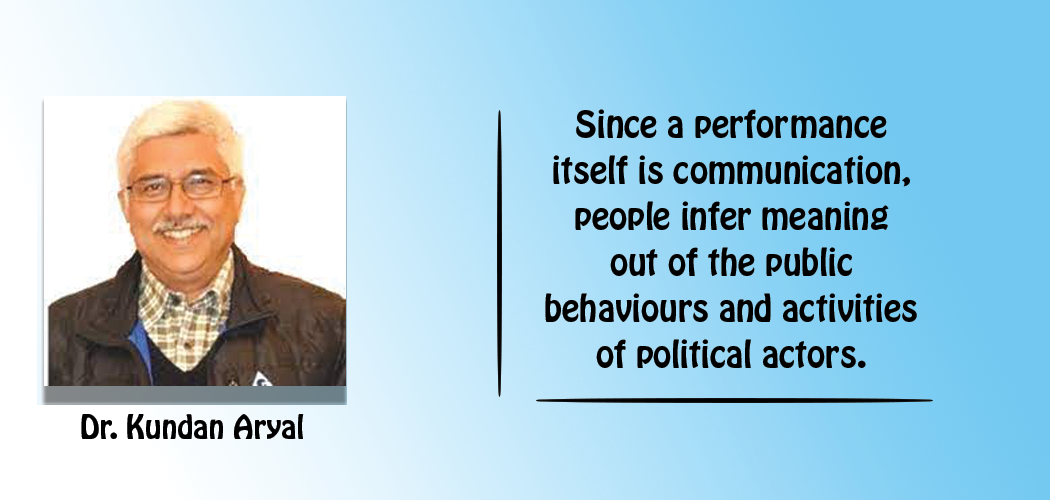- Tuesday, 6 January 2026
Message Through The Ballot
Dr. Kundan Aryal
In elections, people give message through the ballot. Therefore, election results are the outcome of the political communication between the electorates and the elected. After receiving a series of messages through different levels of communication, the electorates cast their votes and pass a final message for a period of time. Recent local elections in Nepal also provide a roadmap of information and communication in the days to come.
There are different avenues of political communication, right from interpersonal, group to the mass communication. However, communication at each level has its own characteristic and importance. Mass media is one of the entities that bridges between the general public and the political leaders.
Mediated communication
Communication through different forms of mass media is considered as mediated communication. Unlike direct communication through one-on-one conversation or small group discussion, mass communication tends to be generic. Its message would not be specific for every individual. But an individual encounters various common issues of concerns beyond the channels of mass communication every day. When they start thinking why such things are happening, they enter the sphere of politics. In a democracy, people ventilate their views, concerns and demands through the periodic election. Moreover, the election verdict as a form of message needs to be understood in the context of changing dynamics of political communication.
Communication is a human behaviour. In other words, people get meaning out of the activities of political actors. As political communication serves as a link between the people and leaders so as to make their relationship lively, social media have become instrumental with their immense capability and vibrancy. Now, the general public have acquired a level of media literacy. Since media literacy enables the public to analyse the content, traditional media don't entertain unlimited impact on audience. There are different layers of media effects visible in different turning points of history. Media do have impact on any society, but in this age media possesses negotiated power. Social power of media depends on the quality of the content because people as audience are now able to examine and analyse the content.
Subsequently, people as voters do examine and analyse the content before taking any decision at the ballot box. They simultaneously make their decision by observing the visible activities of the political actors, with the help of semiology. Today, communication and information landscapes have grown tremendously across the world. Nepal is no exception in this regard. Nowadays almost every individual carries mobile phones with them, which is very effective tool for the interpersonal communication and the rapid dissemination of information. This is an age of mass communication that spreads information and ideas with tremendous velocity.
Moreover, this is the age of convenient interpersonal communication, enabling everyone capable to disseminate information swiftly. Individuals are not only capable to receive, but also impart information to a large segment of population instantly. Thus, information and communication sphere of the contemporary world go beyond the mass media. Today, the traditional media is competing with the individual audience because every audience is equipped with the information of every moment. All these dimensions need to be taken into account to look into the contemporary media environment.
The Nepali mass media comprises of print, broadcast and digital forms and accessible to larger number of the people has definitely played an important role in generating political awareness and mobilising public opinion. However, various forms of new media are being proved to be instrumental in a rapidly transforming political environment. There is significant presence of non-traditional media in conducting interactions. Hence, political communication has been shaped by the new form of interactions between the media, political actors and the public. Beyond the sphere of traditional news media, there are social media platforms that circulate non-edited content concerning politics.
Hence, the mass media that upholds ethical and professional values is not a singular instrumental entity for political awareness and creation of public opinion. Print, radio, television and digital media work together with, but not in isolation. All forms of media in the contemporary world jointly build the base that comprises of complexities of the emerging hybrid media environment. The recent elections show that digital and new media has emerged robust mobilisers among the public at least in urban and sub-urban areas. The digital and social media platforms have been transcended into the sphere of political communication.
Public behaviour
Since a performance itself is communication, people infer meaning out of the public behaviours and activities of political actors. They not only listen to the verbal commitments passed by the political actors. Thus, semiotics is equally important in many instances for the construction of meaning and consequently the public opinion. Mass media outlets are instrumental in making political communication by creating and exchanging ideas, opinions and worldviews among general public. Therefore, media literate and critical masses will be supportive for the development of trustworthy mass media in any society.
On one hand, media provide informed choices to the electorates. On the other, media literate citizens guide media to review their performance by demonstrating their ability in analysing the news and views. In this regard, political communication has been greatly influenced by social networking sites. Now they are becoming effective avenues to expose the shortcomings of political actors and hold discourse on political process and rhetoric.
(Dr. Aryal is associated with the Central Department of Journalism and Mass Communication of Tribhuvan University.)













-original-thumb.jpg)



